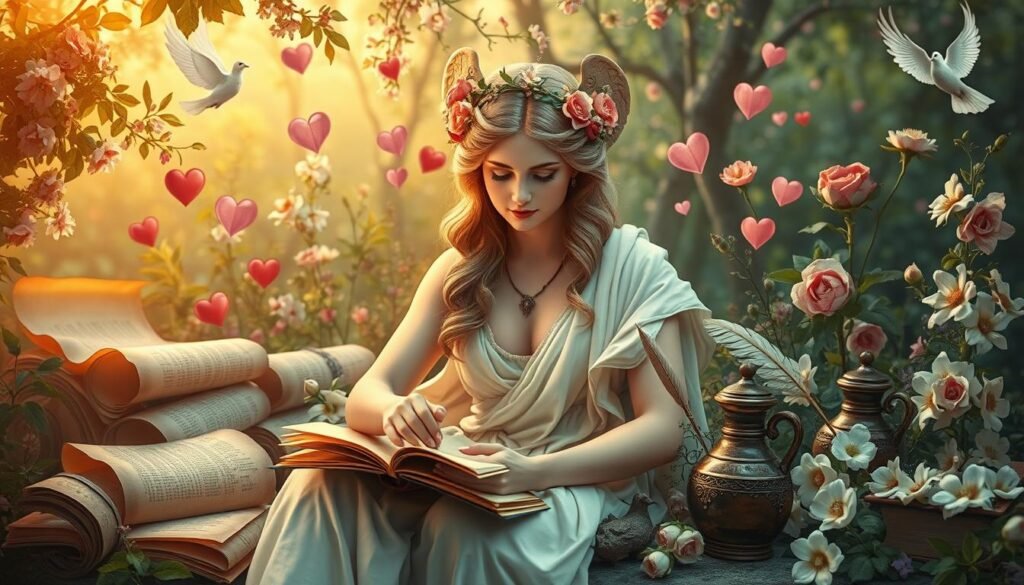Venus, the roman goddess of love, was all about beauty and desire. She was a big deal in ancient Rome. Her presence was everywhere, showing the Romans’ love for fertility and wealth.
Places like Aphrodisias show how artists honored Venus. They made amazing sculptures that brought her to life. Venus’s story is a big part of history, and she’s as interesting today as she was back then.
The Significance of Venus in Roman Culture
Venus worship was big in ancient Rome. It mixed with many parts of Roman life. People honored Venus for love, beauty, and fertility.
They prayed for good love and plenty of food. Women also joined in, linking Venus with other goddesses like Bona Dea.
The Veneralia on April 1st was a big deal. It brought people together, filled with joy and hope. These festivals were about Venus and brought everyone closer.
Venus and Her Greek Counterpart
Venus and Aphrodite are both goddesses of love and beauty. They have captured hearts for centuries. Venus is known for her gentle love, focusing on affection and harmony.
Aphrodite, though, has a more complex side. She mixes love with desire and even war. This shows the dual nature of love in Greek myths.
Both goddesses have stories with other gods, like Mars. These stories highlight the themes of love and passion. They touch the hearts of many across time.
Artistic Representations of Venus
Venus has inspired many artists over time. They show her as a symbol of love and beauty. In ancient Rome, statues and sculptures of Venus showed her grace and charm.
The painting “Rokeby Venus” by Diego Velázquez is a famous example. It was once called “The Toilet of Venus.” It shows Venus’s beauty in a powerful way. Sadly, it got damaged by climate activists.
Artists like Lorenzo Lotto also created works about Venus. His painting “Venus and Cupid” is from the 1520s. It shows a wedding, filled with symbols of love. It shows Venus as a goddess and a part of human love.
Venus’s art continues to touch people today. It shows her lasting impact in art. This includes statues, sculptures, paintings, and mosaics. It helps us understand love and beauty in both old and new ways.
Venus in Literature and Poetry
Venus is a fascinating figure in literature. Roman poets like Ovid often wrote about her. Their works talk about love, desire, and beauty.
In “The Metamorphoses,” Ovid shows Venus’s big impact on humans. This makes her a key part of Roman poetry.
Venus is very important in poetry. She shows both harmony and conflict. This makes her a complex character in literature.
She represents love and inspires creativity. At the same time, she helps us understand the complex nature of desire.

Over time, Venus has been seen in many different ways in literature. Her presence in famous works shows our ongoing interest in love and emotions.
As a muse, Venus keeps inspiring writers. She helps us think about love, beauty, and the connections between people.
The Role of Venus in Roman Society
Venus was very important in Roman society. She was seen as a symbol of love and beauty. People believed she brought love and attraction into their lives.
The Veneralia festival in April was a big deal. It showed how much Romans loved Venus. They asked for her help in finding love and being healthy.
Clothing and fashion were also influenced by Venus. People wore clothes that showed they were connected to her. Statues of Venus helped everyone feel like they were part of a shared culture.
Venus’s stories and art have lasted for a long time. She is seen as a symbol of love in Western art and culture. Her symbols, like doves and roses, mean love to everyone.
Temples Dedicated to Venus
Temples for Venus were big deals in ancient Rome. They showed off the Romans’ skill in building and their love for Venus. Places like the Temple of Venus Genetrix were where people honored Venus’s power over love and fertility.
The buildings were amazing, with fancy columns and decorations. They were big and had lots of room. These temples were key spots for people to meet and talk, showing how important Venus was to them.
But temples for Venus did more than just house worship. They helped shape the city of Rome. They were near other important buildings, making the city’s look and feel better. This shows how Venus was a big part of Roman life, not just in worship but in everyday life too.
Modern Interpretations of Venus
Venus is a big deal in today’s world. She stands for love and beauty in Venus popular culture. Her image pops up in movies, music, and fashion, making her fresh and exciting.
Artists today see Venus in new ways. They show her as strong and empowered, not just pretty. This makes people think differently about what it means to be a woman.
Art about Venus talks about love, self-value, and who we are. It’s a way to understand today’s beauty standards. Artists use Venus to start important conversations.
Venus is a big inspiration for artists and creators. She keeps showing us what love and beauty mean. Her lasting appeal shows she’s more than just a figure from the past.
Venus and Love Myths
The myths about Venus tell us about love’s ups and downs. The story of Cupid and Psyche is a big part of this. It comes from Apuleius’s novel from the 2nd century AD.
Psyche, known in Roman culture as Psyche, looks for love despite Venus’s challenges. Venus makes Psyche do hard tasks to test her love. This story teaches us that love can be tough but worth it.
Psyche meets many gods, like Ceres and Juno. She learns about true love and devotion. This shows how love can change us for the better.
Many have retold the story of Cupid and Psyche in different ways. This includes poetry, drama, and opera. Each version shows how people saw love in the past. Venus’s myths are as interesting today as they were back then.
The Legacy of Venus Today
Venus’s legacy lives on in our world today. It shapes how we see love and beauty. From Valentine’s Day to books, Venus shows us love’s power.
Today, we talk about love in new ways. We think about beauty and relationships differently. Venus helps us see love in a fresh light.
Venus’s story is more than old myths. She teaches us about love’s ups and downs. Her story makes us think about love in our own lives.
